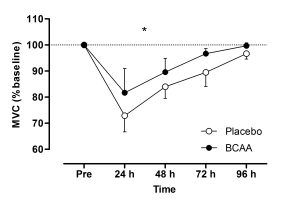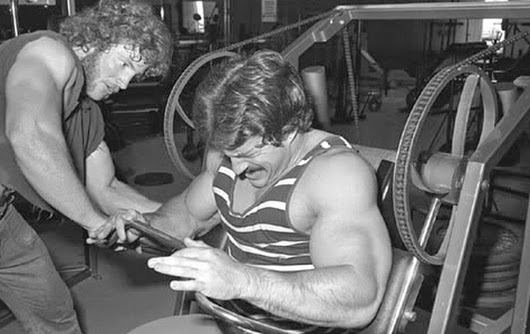Of all types of exercise, weight lifting generally requires the greatest amount of recovery time, which is the period of time you need after lifting weights for the body to fully recover its strength and to be ready for another bout of lifting. This article will touch on what happens when weight training causes muscle damage and inflammation.
Weight training typically causes muscle damage
Lifting weights differs from other types of exercise in that it typically causes muscle damage. I say “typically” because just moving a few weights around, as so many do, won’t damage muscles. But an intense set of repetitions with a heavy weight, done to muscular failure, does cause damage.
It’s often categorically stated that muscles only grow via damage like that inflicted by weight training, but that doesn’t appear to be true. Weight training affects muscles in a number of ways, for instance by activating the molecular machinery for growth, notably mTOR.
Damage does seem to be necessary to activate muscle satellite cells, which are muscle precursor (stem) cells, necessary for adding new muscle cells.1 After 30 and 90 days of resistance training, the number of satellite cells in muscle fibers is greatly increased.
Damage, as to be expected, makes a muscle weaker until the damage is repaired.
Creatine kinase (CK), an enzyme marker of muscle damage, increases in the bloodstream in the days after a bout of resistance training, due to leakage of the enzyme from damaged cells.2 Check out the graph below, which shows an increase in CK, greatest at 24 hours post-training, and subsiding until it returns to normal in about 4 days.

Side note: when someone has a heart attack, the heart muscle is damaged, and a blood test for CK can be used to determine whether the heart has been damaged, i.e whether a heart attack has been taken place.
Muscle soreness increases after training, reaching a peak at 48 hours. See chart below.

This is “delayed onset muscle soreness” or DOMS. I refer to the day that comes two days after my workout as DOMS Day.
When muscle is damaged, it also becomes weaker, and this lasts several days. See below.

Muscles don’t return to normal until about 4 days after hard training.
Why do I feel like crap the day after a workout?
Weight training also acutely increases inflammation, which is a necessary aspect of muscle growth. Cytokines, small messenger molecules, increase inflammation and can be measured after resistance training.3
The chart below shows the increase in gene expression of cytokines following a bout of resistance training.

Inflammatory cytokines are important in what is known as “sickness behavior”. When you’re sick, your body tells you to rest, and you feel fatigued and depressed. In clinical depression, much the same thing happens. Inflammatory cytokines are behind both sickness behavior and depression. 4
Now you know why you can feel so awful in the days following a hard workout. Inflammatory cytokines increase, giving rise to sickness behavior and depressed mood. In addition, muscles are weaker.
Can you speed recovery?
You can do a few things to speed recovery.
As can be seen in the graphs above, branched-chain amino acids (BCAAs) increase strength and decrease CK and muscle soreness in the days after exercise. In the study, participants took 10 grams of BCAAs, twice a day, which is a fairly hefty amount.
Whey protein contains a large fraction of BCAAs, about 25%. Or you could supplement with BCAAs.
Unfortunately, inflammation is a necessary process to muscle growth, and dampening it may negate some of the muscle growth you want from weight training.
Non-steroidal anti-inflammatory drugs (NSAIDs), such as aspirin and ibuprofen, dampen inflammation, but regular use of them may also dampen muscle growth by inhibiting muscle protein synthesis.5
This is probably the same effect seen in the effect of cold exposure after training, in which immersion in cold water strongly inhibited measures of muscle growth. Cold water immersion lowers levels of inflammation, and this in turn inhibits muscle growth.
So, beyond providing muscles what they need to grow, namely protein, whey, and/or BCAAs, if you want the benefits of weight training, you may just have to suffer through the recovery period.
Conclusion
Weight training causes muscle damage and inflammation, and these require several days of recovery.
These processes are intrinsic to muscle growth.
Whey protein and BCAAs can speed recovery, but lowering inflammation interferes with muscle growth.
PS: For more, read my book, Muscle Up.
PPS: Check out my Supplements Buying Guide for Men.
- Kadi, Fawzi, et al. “The effects of heavy resistance training and detraining on satellite cells in human skeletal muscles.” The Journal of physiology558.3 (2004): 1005-1012. ↩
- Howatson, Glyn, et al. “Exercise-induced muscle damage is reduced in resistance-trained males by branched chain amino acids: a randomized, double-blind, placebo controlled study.” Journal of the International Society of Sports Nutrition 9.1 (2012): 1. ↩
- Trenerry, Marissa K., et al. “STAT3 signaling is activated in human skeletal muscle following acute resistance exercise.” Journal of applied physiology102.4 (2007): 1483-1489. ↩
- Maes, Michael, et al. “Depression and sickness behavior are Janus-faced responses to shared inflammatory pathways.” BMC medicine 10.1 (2012): 1. ↩
- Trappe, Todd A., et al. “Effect of ibuprofen and acetaminophen on postexercise muscle protein synthesis.” American Journal of Physiology-Endocrinology and Metabolism 282.3 (2002): E551-E556. ↩















22 Comments
“Whey protein and BCAAs can speed recovery, but lowering inflammation interferes with muscle growth.”
Are you suggesting that BCAAs lower inflammation? The sentence structure would seem to imply that, although I don’t see the data in the graphs supporting it.
No, I wasn’t trying to suggest that, and I don’t think they do.
I’ve found L-Citrulline to be a great recovery elixir from weight lifting. I take 1-2 grams on work-out days, depending on how hard I’ve trained. The typical next-day muscle soreness from heavy work-outs has been non-existent for me.
I had never heard of L-Citrulline until your blog. You wrote it was good for improving circulation, and since I’d learned back in the day muscle soreness was from lactic-acid build-up, I figured “Hey, L-Citrulline sounds like it should be good for clearing out lactic acid.” I don’t know how close that is to citrulline’s actual mechanism for being effective, but I can say it’s been great not being sore the day after a work-out; doubly-so when I was first starting out.
I always dread the first 2-3 weeks of a new weight training plan. This time it’s been no sweat. Also, I’ve had a couple occasions where I’ve missed 1.5 to 2 weeks of training, the day after first day back in the gym has been no problem as well. IMO, that’s a huge benefit and worth publicizing. It should be right up there with your anti machine-shaming. 🙂
Hey Allan,
L-Citrulline may well work for you but I don’t think it would be to do with lactic acid build up. This has been erroneously reported as a cause for soreness when studies suggest it is more or less the inverse: https://ajpregu.physiology.org/content/287/3/R502
Right, I’d seen references to the lactic acid theory being debunked, but never followed up on them in any detail. It isn’t that important to me to know the details. Hence, I couched it with “I don’t know how close that is to citrulline’s actual mechanism…”
Regardless, as a working model, “excess metabolites that need flushed away,” whether they be mis-labeled lactic acid or properly identified as cytokines, sufficed for me to think I should see how L-Citrulline worked for a recovery aid. That part I’m happy to say has been great; enough so that I thought I’d mention it, especially since I heard about L-Citrulline from this blog in the first place.
Cheers.
Hi Allan – in thinking about how that might… citrulline cycles back and forth with arginine, and they increase NO2, which makes for better blood vassel dilation, so that could be how it’s working in this case. More blood flow, less lactate, less soreness.
My thinking exactly. Well, starting from “better blood vassel dilation,”
I wonder, if the same could be true for intense aerobic exercises, like running 5k at maximum speed/capacity? I often experience muscle soreness in my legs, usually 2 days after intense running.
Yes, absolutely. Soreness in legs from sprinting, e.g., is from muscle damage.
I was concerned that use of ibuprofen would interfere with muscle gains until Suppversity noted that COX inhibitors actually increase muscle gains in the elderly, while reducing them in young’uns! The blog post is dated Feb 2, 2016 or search “nsaid elderly”.
The satellite cell recruitment thing is for long term gains. In the short run it won’t make a noticeable difference. If that study was only a few weeks long the satellite inhibition would not have a noticeable effect.
Considering you lift 3 days a week it’s wise to supplement BCAAs on rest days?
You might get better muscle growth doing that.
Great article, I always said to my trainers that 48 hours is not enough to recovery based on a A – B- C series! 96 hours or four days is the proper timing! Regards
So are the inflammatory cytokines a systemic issue? That is, if I work my legs today, should I wait until the cytokines clear (looks like at least 24 hours) before my next work out (whatever body part that might be)? Apologies in advance for what might be a basic question….
Shaq, I’d say that if you feel fine with doing it, go ahead. Cytokines are systemic, and my point is that they cause fatigue, feeling unwell, and are part and parcel of the recovery process and muscle growth. Balance is necessary: hard lifting followed by rest. Recovery times differ a lot between people, especially older vs younger.
Great post, PD. Couple of comments and questions below, if you would.
Do you find that your need for sleep, and your craving for protein, goes up on DOMs days?
I’ve heard it said you should eat more on your workout days, but this never made sense to me. Wouldn’t it make more sense to eat more on the couple of days following the workout?
When I go on a holiday or do anything where I want to feel energetic and clear-headed, I make sure to either go easy on the weights, or skip a session. The same goes when I know I won’t get much sleep.
If you’ve ever experienced a short, poor sleep on a night that happens to follow a heavy squat session, the next day is utter inanition and drowsiness.
Thanks – I definitely need more sleep on DOMS days, but can’t say I crave protein any more or less then. As for eating, I believe in getting some protein such as whey immediately after a workout, but otherwise eat to satiety, whether the day is a workout day or not.
Would dynamic stretching mitigate some of the downsides? Yoga or even total body movements like burpees?
I rather doubt it. I’m not a fan of stretching; it’s probably not bad for you, although I know little about what it might do. Same for yoga and burpees. Cold water immersion fights inflammation, but as noted, may have downsides in terms of muscle hypertrophy.